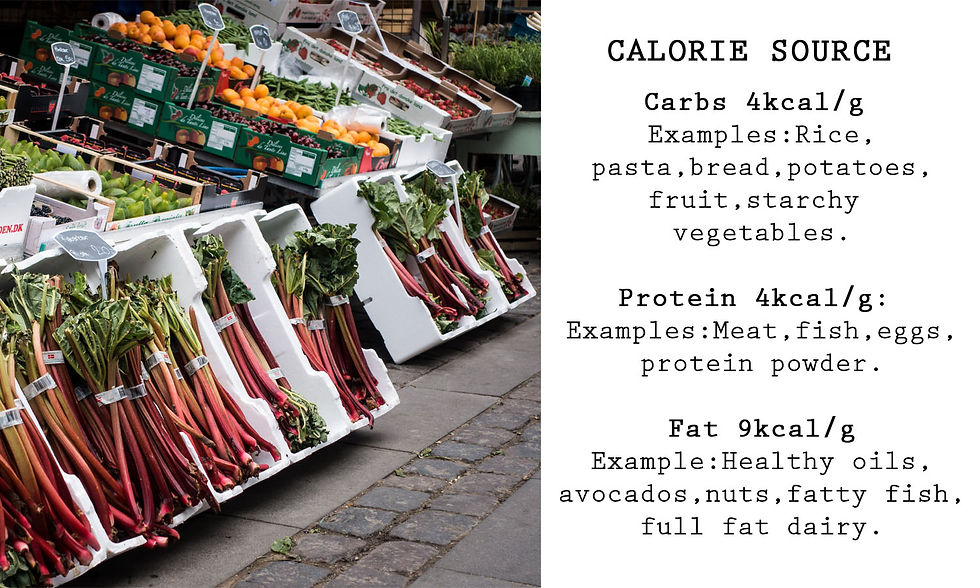What are Macros?
- Kris Myers
- Jul 21, 2020
- 3 min read
Macros or Macro-nutrients make up the calorie content of food. If you look at a Nutrition label you will see them broke down into categories such as Fats, Proteins and Carbohydrates. It's important to count your Macro's along with your calories to meet your health goals such as weight loss, muscle building, etc. Since we all have different goals it's important to understand what each of these Macros will do for you.

Carbohydrates
Also referred to as Carbs are composed of sugars and are the primary energy source for the body. Carbs are found in many foods, mostly in grains, fruits and vegetables as well as sports drinks, gels and bars. As a primary energy source you can see how it's important not cut these out of your diet for prolonged periods. When we eat them is also important to understand especially if you are training or exercising (more on this later). Carbs can also be broken down into Simple and Complex Carbohydrates. Simple carbohydrates are processed quickly in our bodies and raise our blood sugar quickly causing a spike and a drop in our blood sugar levels. Which causes you to be tired after eating them. Complex carbohydrates are processed slower in the body and are a lasting energy that does not cause spikes and drops in the blood sugar but rather a constant energy. Examples include:
Simple Carbohydrates - White Rice, Table Sugar, Syrups, Soft Drinks, White Pasta, White Bread, Products made with White Flour, Fruit Preserves/Jams, 2% Milk, and Chocolate to name just a few.
Complex Carbohydrates - Brown Rice, Many Fruits and Vegetables, Legumes, Lentils, Low Fat Dairy products such as Yogurt, Multigrain bread products, Oatmeal, Soybean, and Barley to name a few.

Quick Quiz: Is this item a Simple or Complex Carbohydrate?
Answer: Simple
Fats
Fats also known as lipids often get a bad wrap because there is so much of it in a processed food diet. Not to mention our fat cells within our body get loaded with them which may be what's bringing you here. There's a difference between good fats and bad fats. Good fats are necessary for providing structure to our body tissues such as nerves and cell membranes. We are constantly rebuilding cells and tissues within our body and need fats for this process. Bad fats are known as Saturated fat, Trans Fats and bad cholesterol. Good fats are polyunsaturated, monounsaturated fats, and Omega 3 and 6.
Foods high in Unsaturated fats include - predominantly found in foods from plants, such as vegetable oils, nuts and seeds.
Monounsaturated fats are found in Olives, Peanuts, Canola Oils, Avocados, nuts such as Hazelnuts, Almonds and Pecans. Seeds such as Pumpkin and Sesame.
Polyunsaturated fats can be found in Sunflower, Corn, Soybean, and Flaxseed oils, Walnuts, Fish and Canola Oil.
Omega 3 Fats are a type of polyunsaturated fat and can be found in fish, flax seed, walnuts and canola or soybean oil.

Proteins
Most people think of protein as the body builder food, and though you are not wrong protein is important for everyone in the right form and quantity. Composed of essential and non-essential amino acids proteins are involved in growth and repair of body tissue as well as cell and body functioning. Proteins also provide some energy and help keep you feeling full longer. Proteins can be found in mostly dairy and meat products.
Like all of the other Macros protein should be consumed based on your health needs, body weight goals and when you workout. The Recommended Dietary Allowance (RDA) for protein is a modest 0.8 grams of protein per kilogram of body weight (sedentary). The RDA is the amount of a nutrient you need to meet your basic nutritional requirements. In a sense, it’s the minimum amount you need to keep from getting sick — not the specific amount you are supposed to eat every day.
Good sources of Protein include - Tuna, Salmon, Haddock, Trout, Turkey, Chicken, Greek Yogurt, Cottage Cheese, Cooked Beans, Milk, Pasta, Nuts and Egg. (source: USDA National Nutrient Database 2015)

Now that you have an understanding of what Macros are you can educate yourself in eating what you need to meet your goals. When eating a macro driven diet
you have the freedom to eat what you want and are not eliminated macros out of your diet.
it's easy to follow
We can eat balanced macros all of our life and not worry about Yo-Yo Diets of losing and gaining weight.
is less stressful in finding foods to eat while out with friends, at a gathering, or out to eat.
is flexible in meeting your needs for training, food allergies, or specific health needs for other health conditions.
Check back soon on how to track your macros to meet your goals.





Comments